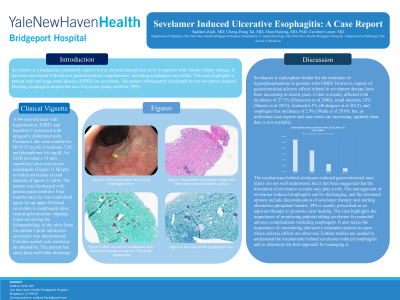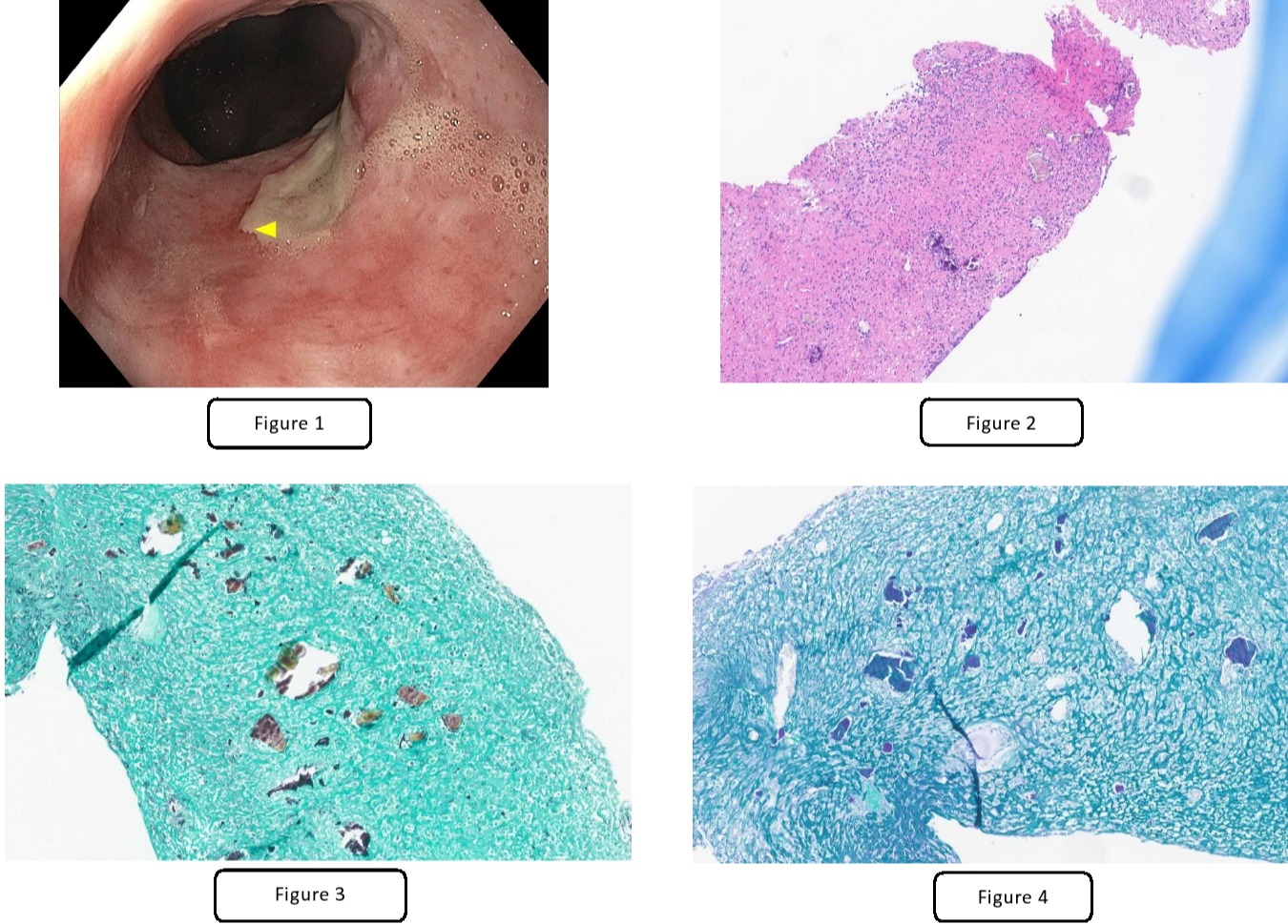Tuesday Poster Session
Category: Esophagus
P3304 - Sevelamer Induced Ulcerative Esophagitis: A Case Report
Tuesday, October 24, 2023
10:30 AM - 4:00 PM PT
Location: Exhibit Hall

Has Audio

Saddam Zaidi, MD
Yale New Haven Health/Bridgeport Hospital
Bridgeport, CT
Presenting Author(s)
Saddam Zaidi, MD1, Cheng-Hung Tai, MD1, Haiying Zhan, MD, PhD2, Caroline Loeser, MD1
1Yale New Haven Health/Bridgeport Hospital, Bridgeport, CT; 2Yale New Haven Hospital, New Haven, CT
Introduction: Sevelamer is a medication commonly used to lower elevated phosphorus level in patients with chronic kidney disease. It has been associated with adverse gastrointestinal complications, including esophagitis and colitis. This case highlights a patient with end stage renal disease (ESRD) on sevelamer. The patient subsequently developed severe sevelamer-induced bleeding esophagitis despite the use of a proton-pump inhibitor (PPI).
Case Description/Methods: A 64-year-old man with hypertension, ESRD, and hepatitis C presented with epigastric abdominal pain. Pertinent Labs were notable for BUN 35 mg/dl, Creatinine 7.29, and phosphorus 6.6 mg/dl. An EGD revealed a 14 mm superficial ulcer and severe esophagitis. Biopsy revealed sevelamer crystal deposits. The patient was discharged with proton pump inhibitor. Four months later, he was readmitted again for an upper GI bleed secondary to esophageal ulcer, requiring hemostatic clipping. Upon reviewing the histopathology of the ulcer from the patient’s prior admission, sevelamer was discontinued, and calcium acetate was started as an alternative. The patient has since done well after discharge.
Discussion: Sevelamer is a phosphate binder for the treatment of hyperphosphatemia in patients with ESRD. However, reports of gastrointestinal adverse effects related to sevelamer therapy have been increasing in recent years. Colon mainly affected with incidence of 27.3% (Francesco et al 2006), small intestine 18% (Shastri et al 2015), stomach 6.5% (Rodriguez et al 2012), and esophagus has incidence of 2.9% (Wada et al 2019); but, as individual case reports and case series are increasing, updated clear data is not available. The mechanisms behind sevelamer-induced gastrointestinal tract injury are not well understood, but it has been suggested that the formation of sevelamer crystals may play a role. The management of sevelamer-induced esophagitis can be challenging, and the treatment options can include discontinuation of sevelamer therapy and starting alternative phosphate binders. PPI is usually prescribed as an adjuvant therapy to promote ulcer healing. The case highlights the importance of monitoring patients taking sevelamer for potential adverse complications including esophagitis. It also raises the importance of considering alternative treatment options in cases where adverse effects are observed. Further studies are needed to understand the mechanisms behind sevelamer-induced esophagitis and to determine the best approach for managing it.

Disclosures:
Saddam Zaidi, MD1, Cheng-Hung Tai, MD1, Haiying Zhan, MD, PhD2, Caroline Loeser, MD1. P3304 - Sevelamer Induced Ulcerative Esophagitis: A Case Report, ACG 2023 Annual Scientific Meeting Abstracts. Vancouver, BC, Canada: American College of Gastroenterology.
1Yale New Haven Health/Bridgeport Hospital, Bridgeport, CT; 2Yale New Haven Hospital, New Haven, CT
Introduction: Sevelamer is a medication commonly used to lower elevated phosphorus level in patients with chronic kidney disease. It has been associated with adverse gastrointestinal complications, including esophagitis and colitis. This case highlights a patient with end stage renal disease (ESRD) on sevelamer. The patient subsequently developed severe sevelamer-induced bleeding esophagitis despite the use of a proton-pump inhibitor (PPI).
Case Description/Methods: A 64-year-old man with hypertension, ESRD, and hepatitis C presented with epigastric abdominal pain. Pertinent Labs were notable for BUN 35 mg/dl, Creatinine 7.29, and phosphorus 6.6 mg/dl. An EGD revealed a 14 mm superficial ulcer and severe esophagitis. Biopsy revealed sevelamer crystal deposits. The patient was discharged with proton pump inhibitor. Four months later, he was readmitted again for an upper GI bleed secondary to esophageal ulcer, requiring hemostatic clipping. Upon reviewing the histopathology of the ulcer from the patient’s prior admission, sevelamer was discontinued, and calcium acetate was started as an alternative. The patient has since done well after discharge.
Discussion: Sevelamer is a phosphate binder for the treatment of hyperphosphatemia in patients with ESRD. However, reports of gastrointestinal adverse effects related to sevelamer therapy have been increasing in recent years. Colon mainly affected with incidence of 27.3% (Francesco et al 2006), small intestine 18% (Shastri et al 2015), stomach 6.5% (Rodriguez et al 2012), and esophagus has incidence of 2.9% (Wada et al 2019); but, as individual case reports and case series are increasing, updated clear data is not available. The mechanisms behind sevelamer-induced gastrointestinal tract injury are not well understood, but it has been suggested that the formation of sevelamer crystals may play a role. The management of sevelamer-induced esophagitis can be challenging, and the treatment options can include discontinuation of sevelamer therapy and starting alternative phosphate binders. PPI is usually prescribed as an adjuvant therapy to promote ulcer healing. The case highlights the importance of monitoring patients taking sevelamer for potential adverse complications including esophagitis. It also raises the importance of considering alternative treatment options in cases where adverse effects are observed. Further studies are needed to understand the mechanisms behind sevelamer-induced esophagitis and to determine the best approach for managing it.

Figure: Figure 1: EGD image shows the 14 mm esophageal ulcer
Figure 2: High power microscopic image with E&H stain shows sevelamer crystals
Figure 3: GMS stain of the esophageal ulcer. Sevelamer cystals are seen in “Fish-Scale” appearance
Figure 4: PAS stain of the esophageal ulcer
Figure 2: High power microscopic image with E&H stain shows sevelamer crystals
Figure 3: GMS stain of the esophageal ulcer. Sevelamer cystals are seen in “Fish-Scale” appearance
Figure 4: PAS stain of the esophageal ulcer
Disclosures:
Saddam Zaidi indicated no relevant financial relationships.
Cheng-Hung Tai indicated no relevant financial relationships.
Haiying Zhan indicated no relevant financial relationships.
Caroline Loeser indicated no relevant financial relationships.
Saddam Zaidi, MD1, Cheng-Hung Tai, MD1, Haiying Zhan, MD, PhD2, Caroline Loeser, MD1. P3304 - Sevelamer Induced Ulcerative Esophagitis: A Case Report, ACG 2023 Annual Scientific Meeting Abstracts. Vancouver, BC, Canada: American College of Gastroenterology.
